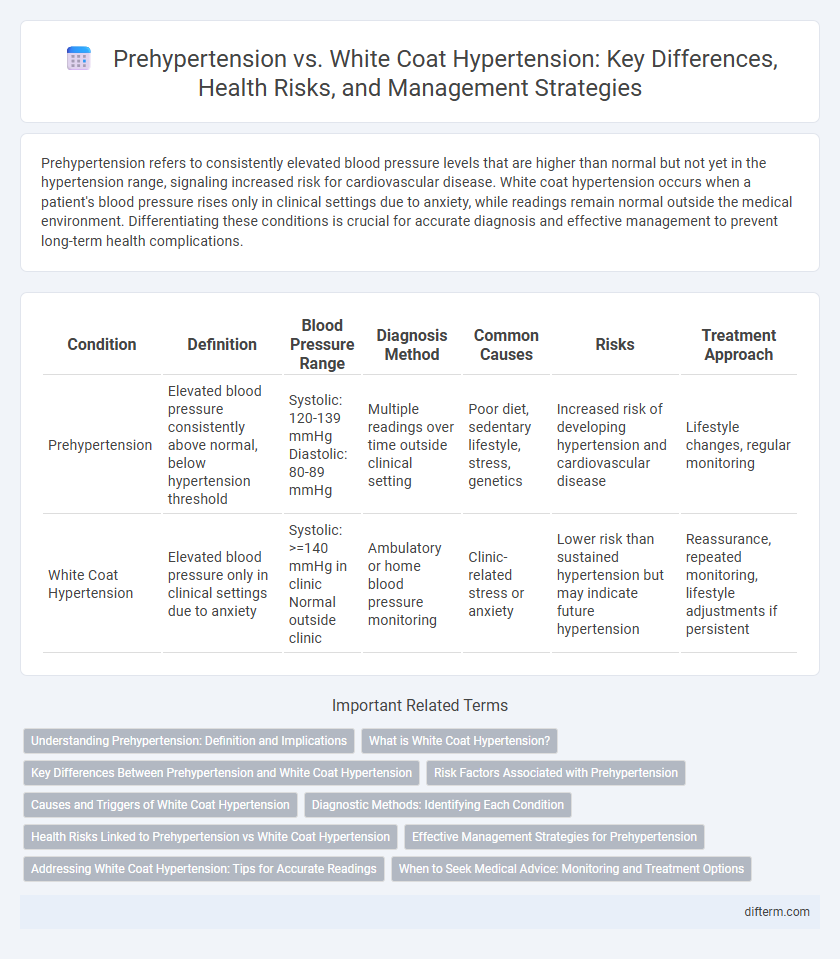Prehypertension refers to consistently elevated blood pressure levels that are higher than normal but not yet in the hypertension range, signaling increased risk for cardiovascular disease. White coat hypertension occurs when a patient's blood pressure rises only in clinical settings due to anxiety, while readings remain normal outside the medical environment. Differentiating these conditions is crucial for accurate diagnosis and effective management to prevent long-term health complications.
Table of Comparison
| Condition | Definition | Blood Pressure Range | Diagnosis Method | Common Causes | Risks | Treatment Approach |
|---|---|---|---|---|---|---|
| Prehypertension | Elevated blood pressure consistently above normal, below hypertension threshold | Systolic: 120-139 mmHg Diastolic: 80-89 mmHg |
Multiple readings over time outside clinical setting | Poor diet, sedentary lifestyle, stress, genetics | Increased risk of developing hypertension and cardiovascular disease | Lifestyle changes, regular monitoring |
| White Coat Hypertension | Elevated blood pressure only in clinical settings due to anxiety | Systolic: >=140 mmHg in clinic Normal outside clinic |
Ambulatory or home blood pressure monitoring | Clinic-related stress or anxiety | Lower risk than sustained hypertension but may indicate future hypertension | Reassurance, repeated monitoring, lifestyle adjustments if persistent |
Understanding Prehypertension: Definition and Implications
Prehypertension refers to blood pressure levels consistently ranging between 120-139 mm Hg systolic or 80-89 mm Hg diastolic, signaling increased risk for developing hypertension and cardiovascular diseases. Unlike white coat hypertension, which is elevated blood pressure observed only in clinical settings due to anxiety, prehypertension indicates a persistent condition requiring lifestyle modification and monitoring. Early recognition of prehypertension is crucial for preventing progression to chronic hypertension and associated complications such as heart attack, stroke, and kidney damage.
What is White Coat Hypertension?
White Coat Hypertension is a condition where a patient's blood pressure readings are elevated in a clinical setting but remain normal outside of the medical environment. This phenomenon occurs due to anxiety or stress triggered by being in a doctor's office, leading to temporary increases in blood pressure. Unlike prehypertension, which indicates a consistent risk of developing hypertension, White Coat Hypertension requires ambulatory blood pressure monitoring for accurate diagnosis.
Key Differences Between Prehypertension and White Coat Hypertension
Prehypertension is characterized by consistently elevated blood pressure readings ranging from 120-139/80-89 mmHg, indicating a higher risk of developing hypertension and cardiovascular diseases. White coat hypertension occurs when blood pressure readings are elevated only in clinical settings due to anxiety, while normal readings are observed in everyday environments. The key difference lies in the persistence and context of elevated readings, with prehypertension reflecting sustained hypertension risk and white coat hypertension representing situational, stress-induced spikes.
Risk Factors Associated with Prehypertension
Prehypertension is characterized by consistently elevated blood pressure readings ranging from 120-139/80-89 mmHg, which increases the risk of developing hypertension and cardiovascular disease. Key risk factors include obesity, sedentary lifestyle, high sodium intake, excessive alcohol consumption, and a family history of hypertension. Unlike white coat hypertension, where elevated readings occur only in clinical settings due to anxiety, prehypertension represents a sustained blood pressure elevation requiring lifestyle modification to prevent progression.
Causes and Triggers of White Coat Hypertension
White Coat Hypertension is primarily triggered by anxiety or stress experienced in clinical settings, leading to temporary elevated blood pressure readings. Causes include fear of medical environments and heightened sympathetic nervous system activity during doctor visits. Unlike prehypertension, which involves consistently elevated blood pressure due to lifestyle factors such as diet and inactivity, white coat hypertension is situational and often resolves outside medical contexts.
Diagnostic Methods: Identifying Each Condition
Prehypertension is identified through consistent elevated blood pressure readings ranging from 120-139 mm Hg systolic or 80-89 mm Hg diastolic during multiple clinical visits. White coat hypertension is diagnosed by contrasting elevated blood pressure measurements in a clinical setting with normal levels recorded via ambulatory blood pressure monitoring (ABPM) or home blood pressure monitoring (HBPM). Accurate differentiation between these conditions relies heavily on repeat measurements outside the clinical environment to avoid misclassification and guide appropriate management.
Health Risks Linked to Prehypertension vs White Coat Hypertension
Prehypertension increases the risk of developing chronic hypertension, heart disease, stroke, and kidney damage due to consistently elevated blood pressure levels. White coat hypertension, characterized by elevated readings only in clinical settings, generally poses a lower risk but may indicate underlying anxiety that can contribute to cardiovascular issues if untreated. Monitoring and managing prehypertension is crucial to prevent progression, while white coat hypertension requires accurate diagnosis to avoid unnecessary treatment and focus on stress management.
Effective Management Strategies for Prehypertension
Effective management strategies for prehypertension emphasize lifestyle modifications such as adopting a DASH diet rich in fruits, vegetables, and low-fat dairy, increasing physical activity to at least 150 minutes per week, and reducing sodium intake below 2,300 mg daily. Regular blood pressure monitoring helps distinguish prehypertension from white coat hypertension, ensuring accurate diagnosis and tailored interventions. Stress reduction techniques including mindfulness and biofeedback contribute to maintaining optimal blood pressure and preventing progression to hypertension.
Addressing White Coat Hypertension: Tips for Accurate Readings
White coat hypertension occurs when blood pressure readings are elevated in a clinical setting but normal at home, often due to anxiety. To obtain accurate blood pressure measurements, patients should monitor their readings at home using validated devices and maintain a consistent routine, such as resting for five minutes before measurement. Healthcare providers recommend multiple readings over several days to distinguish white coat hypertension from prehypertension, ensuring appropriate diagnosis and treatment decisions.
When to Seek Medical Advice: Monitoring and Treatment Options
Prehypertension indicates blood pressure consistently ranging from 120-139/80-89 mm Hg, necessitating lifestyle changes and regular monitoring to prevent progression to hypertension. White coat hypertension occurs when blood pressure spikes in clinical settings but remains normal at home, requiring ambulatory blood pressure monitoring for accurate diagnosis. Seek medical advice if home readings or ambulatory monitoring show sustained elevated pressure, as untreated conditions increase risks for cardiovascular disease and may require pharmacologic treatment.
Prehypertension vs White Coat Hypertension Infographic

 difterm.com
difterm.com